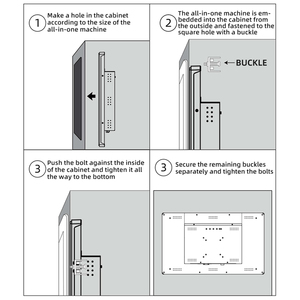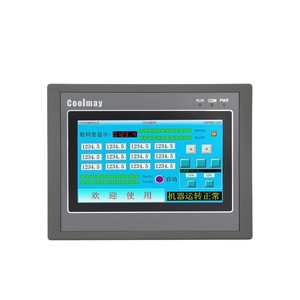(967 products available)














































































































































































































The HMI development software is used to create an HMI, which is a fusion of hardware and software components. The hardware part consists of a computer with a screen, and the software contains programs that allow operators to manage processes or machines. Given that an HMI is a system, it is categorized as system HMI or HMI system and HMI development software.
The HMI system can be classified into different types based on its function and features. This includes:
The HMI development software can also be categorized into three groups:
The key to creating good HMIs is drawing the operator's attention. Therefore, the HMI software features and functions must help system operators perform their tasks easily and quickly. Here are some integral characteristics of the HMI development software:
Intuitive Development Environment
Human machine interface development software provides developers with an easy-to-use workspace. It has drag-and-drop features that allow seamless shifting of elements into screens. Channels and tags are also moved effortlessly and linked to the graphical elements. The virtual HMI simulator allows developers to test their projects during the development phase.
Graphic Toolkits
The graphic toolkits enable developers to create a clear and precise Human Machine Interface. They can use a wide range of graphic elements, such as symbols, gauges, charts, and buttons. In addition, consistent graphic representation improves comprehension, reduces error, and promotes operational efficiency.
Data Integration Tools
Data integration tools allow for smooth data transfer between different applications, systems, and devices. They ensure the HMI system gets accurate data from various sources. In addition, development software with data integration tools can receive and send data in real time. This facilitates better decision-making and improves operational efficiency.
Multi-platform Support
For increased flexibility, HMI development software offers multi-platform support. Developers can deploy applications for various operating systems, such as embedded Linux, Windows CE, iOS, and Android. The multi-platform support feature allows operators to access applications on various devices. This improves productivity and operational efficiency.
Cloud Connectivity
Cloud connectivity enables HMIs to store data in the cloud. This easily stores, analyzes, and manages data from different machines and systems. It also allows users to access data remotely and keep the system updated. Users receive software updates and can monitor system performance in real-time.
Data Visualization
Data visualization converts complex data into easy-to-understand visual presentations. Velocity HMI software uses graphs, charts, and dashboards to present operational data. This makes it easy for operators to identify trends, patterns, and anomalies in the data. Effective data visualization improves decision-making and enhances situational awareness.
Alarm Management
The Alarm Management feature enhances operational safety and helps operators respond to critical situations quickly. It provides alarm logging, which allows analysis of alarm data. Operators can determine the cause of an alarm and take necessary steps to prevent abnormal occurrences.
Security Features
Human machine interface software has many security features to protect sensitive data. Security measures include user authentication, data encryption, access control, and network security.
HMI software can be applied across many industries and has become crucial for streamlining operations and enhancing productivity. Here is a list of various applications or industries where HMI development software is applied:
To choose the right HMI software for development, one must evaluate their specific needs and budget. They should consider the type of HMI application, the target industry, the complexity of the project, the level of customization required, and the available budget and resources.
When selecting HMI development software, it is critical to ensure the software supports the hardware. One should verify that the HMI development software is compatible with the hardware devices, such as PLCs, sensors, and touch screens, and that it can easily integrate with them. It is crucial to check the communication protocols supported by the software and ensure they match those used by the hardware devices.
The next step involves looking at the features and functionalities of the HMI development software. One should evaluate the features necessary for developing the desired HMI application. Some essential features to consider are alarm management, data logging, trend analysis, user management, and multi-touch gestures.
One must then prioritize ease of use and productivity. It is critical to choose HMI development software with an intuitive interface and efficient development tools. A user-friendly interface can speed up the development process, while efficient tools like drag-and-drop. It helps make the software more attractive and saves time and resources. It is essential to consider the level of customization and flexibility offered by the HMI development software. Customization allows developers to tailor the HMI design to suit specific requirements and preferences.
Developers should look for software that provides flexible options for customizing graphics, layouts, colors, fonts, and widgets. This ensures that the final HMI interface looks good and meets the unique needs of the application. One must also consider the connectivity options and protocols supported by the HMI development software. Connectivity allows the HMI application to interact with various devices, systems, and data sources.
It's essential to check the communication protocols, such as MQTT, Modbus, OPC UA, HTTP, TCP/IP, and others supported by the software.
Q1: Does HMI software come with pre-built templates?
A1: Many HMI development software offers a variety of pre-built templates and widgets to accelerate the design process. These templates can be customized to meet specific requirements.
Q2: What devices can the HMIs connect to?
A2: The HMI development software provides applications compatible with various devices, including industrial PCs, touch terminals, tablets, and smartphones. This enables widespread monitoring and control.
Q3: Is it possible to access the HMI remotely?
A3: Various HMI development software allows remote access to the HMI. This enables operators to monitor and control industrial processes from virtually any location.